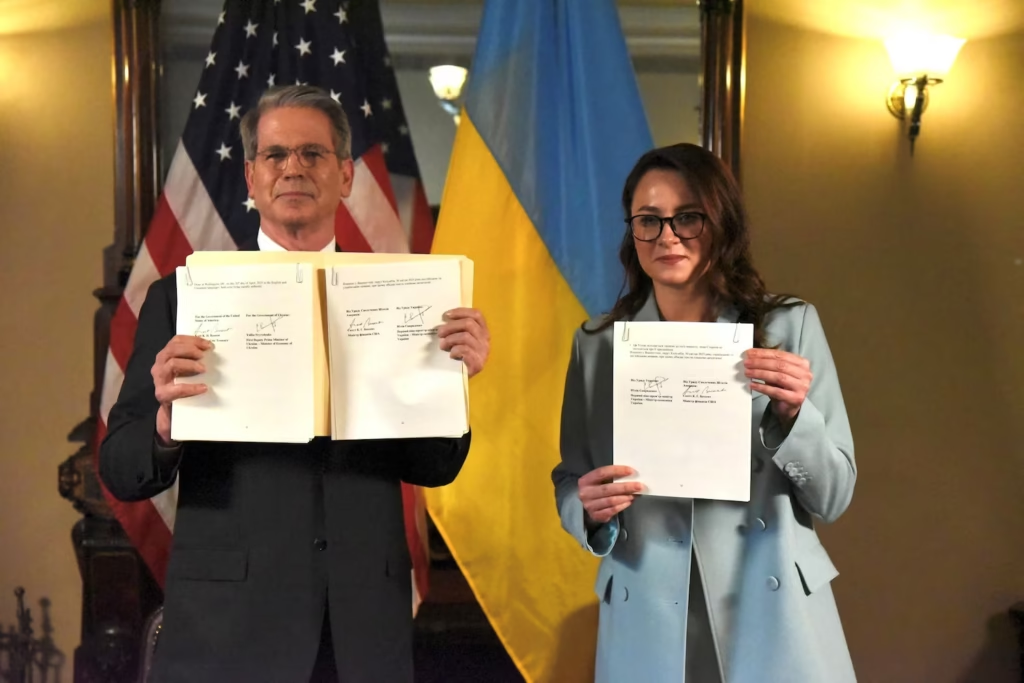On April 30, 2025, the United States and Ukraine signed a landmark minerals-sharing agreement in Washington, D.C., signaling a renewed phase of strategic partnership between the two nations. The deal, reached after months of negotiations, is framed as a key move to aid Ukraine’s economic recovery amid its ongoing war with Russia.
Strategic Goals: Economic Recovery and U.S. Investment
U.S. Treasury Secretary Scott Bessent, a key architect of the deal, highlighted the agreement as a vehicle for unlocking Ukraine’s growth potential through American investment, governance, and capital. According to Bessent:
“This partnership allows the United States to invest alongside Ukraine, mobilize American talent, and improve Ukraine’s investment climate.”
Access to Critical Minerals and Long-Term Benefits
Ukraine, rich in lithium, rare earth elements, and other strategic minerals, will grant preferential access to the U.S. These materials are essential to industries such as renewable energy, electric vehicles, and defense technologies. The deal is expected to provide a major boost to Ukraine’s battered economy while helping the U.S. secure supply chains in critical sectors.
Ukraine’s Commitment to Sovereignty and EU Integration
Ukrainian Prime Minister Denys Shmyhal reassured the public that the deal does not threaten Ukraine’s sovereignty or its aspiration to join the European Union. He emphasized that the agreement was crafted to align with Ukraine’s long-term goals of independence and economic growth.
Mixed Reactions Within Ukraine’s Parliament
Despite official optimism, several Ukrainian lawmakers expressed caution. Oleksandr Merezhko, head of the Rada’s foreign affairs committee, voiced unease:
“It’s too early to fully evaluate the agreement, but it seems like we have managed to avoid turning U.S. military aid into debt.”
This sentiment reflects broader concerns in the Verkhovna Rada over potential U.S. influence on Ukraine’s economy and future decision-making autonomy.
U.S. Position: Strategic Support Against Russian Aggression
From the U.S. perspective, the deal sends a powerful signal to Russia. Treasury Secretary Bessent described the agreement as a step toward peace:
“This agreement is a clear signal that the U.S. is committed to a peace process centered on a free and sovereign Ukraine.”
President Donald Trump, who has made Ukraine a focal point of his foreign policy, emphasized that this deal reinforces U.S. support for Eastern European allies and counters Russian influence.
Russia’s Backlash: Medvedev Criticizes the Agreement
Dmitry Medvedev, Russia’s former president and current Security Council deputy chair, called the agreement a defeat for Ukraine. On social media, he claimed Ukraine is “paying for military aid with its national wealth,” echoing Moscow’s criticism of Western involvement in Ukraine’s affairs.
Economic and Political Implications for Ukraine
As Ukraine works to rebuild, the deal is expected to attract foreign investment in infrastructure, energy, and technology. However, critics warn that excessive dependence on the U.S. could limit Ukraine’s economic independence and complicate its alignment with EU standards.
What’s Next: Scrutiny and Implementation
The full details of the deal have yet to be made public, and lawmakers in both countries are expected to scrutinize its implications in the coming weeks. Ukrainian officials are particularly focused on ensuring the agreement aligns with national interests and doesn’t hinder EU accession efforts.
Conclusion: A High-Stakes Deal with Global Implications
The U.S.-Ukraine minerals-sharing agreement marks a pivotal moment in post-war geopolitics. For Ukraine, it offers a path toward economic revival and strategic integration with the West. For the U.S., it secures vital resources and reaffirms its commitment to democracy in Eastern Europe. While political risks remain, the deal could be a cornerstone of Ukraine’s recovery—if managed wisely.

